

ExploreSouthernHistory.com - Tallulah Gorge & Waterfalls, Georgia
ExploreSouthernHistory.com - Tallulah Gorge & Waterfalls, Georgia

| Tallulah Gorge State Park The magnificent Georgia canyon reaches depths of nearly 1,000 feet and is one of the deepest in the eastern United States. |
Tallulah Gorge State Park
A spectacular natural wonder
known for its waterfalls, trails
and stunning canyon, the park
is in Tallulah Falls, Georgia.
A spectacular natural wonder
known for its waterfalls, trails
and stunning canyon, the park
is in Tallulah Falls, Georgia.


Waterfalls of Tallulah Gorge
A series of beautiful waterfalls
can be found at the bottom of
the gorge. Several can even
be seen from the canyon rim.
A series of beautiful waterfalls
can be found at the bottom of
the gorge. Several can even
be seen from the canyon rim.
Tallulah Gorge State Park & Waterfalls - Tallulah Falls, Georgia
Spectacular 1000 Foot Canyon
| Copyright 2011 by Dale Cox All rights reserved. |


Custom Search
Amicalola Falls State Park
Franklin D. Roosevelt State Park
Stone Mountain Park
Kennesaw Mountain Battlefield
Historic Sites in Georgia
Ghosts & Monsters of the South
Natural Wonders of the South
Explore other Southern Historic Sites
Franklin D. Roosevelt State Park
Stone Mountain Park
Kennesaw Mountain Battlefield
Historic Sites in Georgia
Ghosts & Monsters of the South
Natural Wonders of the South
Explore other Southern Historic Sites

Natural Wonder of Georgia
The two-mile long and 1,000
foot deep canyon is ranked as
one of the Seven Natural
Wonders of Georgia.
The two-mile long and 1,000
foot deep canyon is ranked as
one of the Seven Natural
Wonders of Georgia.
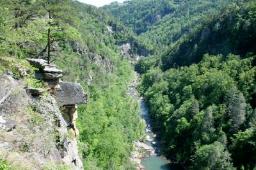
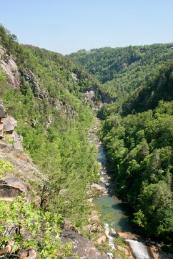
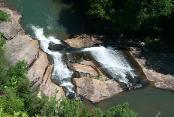
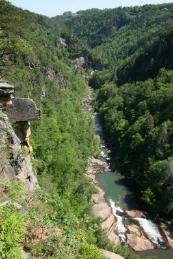

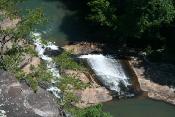
Oceana Falls
One of the six waterfalls that
make up Tallulah Falls,
Oceana Falls is clearly visible
from the canyon overlooks.
One of the six waterfalls that
make up Tallulah Falls,
Oceana Falls is clearly visible
from the canyon overlooks.
Tallulah Gorge State Park is a spectacular
joint venture of the Georgia Department of
Natural Resources and Georgia Power that
preserves one of the deepest canyons in the
eastern United States.
Located within the city limits of Tallulah Falls,
Georgia, the canyon reaches depths of nearly
1,000 feet and features seven key waterfalls.
Two miles long, the gorge is rich in both
natural and cultural history and is ranked as
one of the Seven Natural Wonders of Georgia.
Said to be one of the oldest geological
features in North America, Tallulah Gorge
has been forming for thousands of years.
Prehistoric Indians discovered the canyon
and hunted both along its rim and in its deep
bottom.
When the first European settlers arrived in
the region during the 1820s, they found the
Cherokee living at Tallulah Gorge. Indeed,
the canyon is within the traditional homeland
of the Cherokee people, who lived in Georgia
until they were forcibly removed on the Trail of
Tears in 1838.
While many today believe that the name
"Tallulah" originated with the Cherokee, there
is a bit of a debate on that topic. The name is
similar to a Cherokee word that means "The
Terrible," but the Cherokee themselves knew
the gorge by the name "Ugunyi." The name
"Tallulah" was applied by white settlers at
some point before the Civil War.
The origin of the name aside, local legend
holds that at least one of the early Cherokee
warriors still roams Tallulah Gorge.
The story of the Ghost of Tallulah Falls first
appeared in print in 1891 when a Toccoa
newspaper ran a story on the supposed
haunting of the canyon by a long dead
Cherokee warrior who would frown and then
shoot at intruders. The article was widely
repeated in other newspapers, prompting an
eyewitness to write the Chicago Herald and
tell of his own experience there in 1876:
...(S)uddenly I saw a man rise to his feet with
a very serious look, presenting his deadly
rifle at me. As I turned I shouted, ‘take care of
yourself, Joe!’ I struck a bee line for the hotel.
The sharp report of a pistol followed my good
legs. I cried, I felt the ball hit; I felt the blood
run down my back; but had no time to tarry. I
met Mr. Young in the yard, and after a hearty
laugh he told me it was the ghost of the
Indian that Bailey had killed, and that I was
not the first one that flown from there.
The man, of course, had not been shot but
had encountered the Ghost of Tallulah Falls.
Stories of strange meetings with ghostly
figures continue in the gorge area to this day.
As word of the magnificence of the canyon
and falls spread, people flooded to see the
remarkable natural scenes. Among these
early visitors was the artist George Cooke,
who completed his painting "Tallulah Falls"
in 1841. By the time of the Civil War, the
Tallulah Gorge had become a major tourist
attraction.
The completion of a railroad connecting
Atlanta to the town of Tallulah Falls in 1882
opened the floodgates of tourism. Before
long the town boasted nearly 20 hotels and
boarding houses. Trains rolled in as often as
five times on Sundays, bringing tens of
thousands of people to see the gorge and
falls.
Just as the tourism boom reached its height,
however, Tallulah Falls became the focus of
one of the most dramatic preservation fights
of the early 20th century. On one side was
Georgia Power, which wanted to dam the
Tallulah River to produce electricity. On the
other side were lovers of the natural setting,
led by Helen Dortch Longstreet, the widow of
Confederate general James Longstreet.
joint venture of the Georgia Department of
Natural Resources and Georgia Power that
preserves one of the deepest canyons in the
eastern United States.
Located within the city limits of Tallulah Falls,
Georgia, the canyon reaches depths of nearly
1,000 feet and features seven key waterfalls.
Two miles long, the gorge is rich in both
natural and cultural history and is ranked as
one of the Seven Natural Wonders of Georgia.
Said to be one of the oldest geological
features in North America, Tallulah Gorge
has been forming for thousands of years.
Prehistoric Indians discovered the canyon
and hunted both along its rim and in its deep
bottom.
When the first European settlers arrived in
the region during the 1820s, they found the
Cherokee living at Tallulah Gorge. Indeed,
the canyon is within the traditional homeland
of the Cherokee people, who lived in Georgia
until they were forcibly removed on the Trail of
Tears in 1838.
While many today believe that the name
"Tallulah" originated with the Cherokee, there
is a bit of a debate on that topic. The name is
similar to a Cherokee word that means "The
Terrible," but the Cherokee themselves knew
the gorge by the name "Ugunyi." The name
"Tallulah" was applied by white settlers at
some point before the Civil War.
The origin of the name aside, local legend
holds that at least one of the early Cherokee
warriors still roams Tallulah Gorge.
The story of the Ghost of Tallulah Falls first
appeared in print in 1891 when a Toccoa
newspaper ran a story on the supposed
haunting of the canyon by a long dead
Cherokee warrior who would frown and then
shoot at intruders. The article was widely
repeated in other newspapers, prompting an
eyewitness to write the Chicago Herald and
tell of his own experience there in 1876:
...(S)uddenly I saw a man rise to his feet with
a very serious look, presenting his deadly
rifle at me. As I turned I shouted, ‘take care of
yourself, Joe!’ I struck a bee line for the hotel.
The sharp report of a pistol followed my good
legs. I cried, I felt the ball hit; I felt the blood
run down my back; but had no time to tarry. I
met Mr. Young in the yard, and after a hearty
laugh he told me it was the ghost of the
Indian that Bailey had killed, and that I was
not the first one that flown from there.
The man, of course, had not been shot but
had encountered the Ghost of Tallulah Falls.
Stories of strange meetings with ghostly
figures continue in the gorge area to this day.
As word of the magnificence of the canyon
and falls spread, people flooded to see the
remarkable natural scenes. Among these
early visitors was the artist George Cooke,
who completed his painting "Tallulah Falls"
in 1841. By the time of the Civil War, the
Tallulah Gorge had become a major tourist
attraction.
The completion of a railroad connecting
Atlanta to the town of Tallulah Falls in 1882
opened the floodgates of tourism. Before
long the town boasted nearly 20 hotels and
boarding houses. Trains rolled in as often as
five times on Sundays, bringing tens of
thousands of people to see the gorge and
falls.
Just as the tourism boom reached its height,
however, Tallulah Falls became the focus of
one of the most dramatic preservation fights
of the early 20th century. On one side was
Georgia Power, which wanted to dam the
Tallulah River to produce electricity. On the
other side were lovers of the natural setting,
led by Helen Dortch Longstreet, the widow of
Confederate general James Longstreet.
Great Waterfalls of the South
DeSoto Falls - Alabama
Little River Falls - Alabama
Noccalula Falls - Alabama
Artist Point Falls - Arkansas
Cedar Falls at Petit Jean Mountain - Arkansas
Dogwood Canyon Waterfalls - Missouri
Falling Waters State Park - Florida
Amicalola Falls State Park - Georgia
Natural Falls State Park - Oklahoma
Graveyard Fields & Falls - North Carolina
DeSoto Falls - Alabama
Little River Falls - Alabama
Noccalula Falls - Alabama
Artist Point Falls - Arkansas
Cedar Falls at Petit Jean Mountain - Arkansas
Dogwood Canyon Waterfalls - Missouri
Falling Waters State Park - Florida
Amicalola Falls State Park - Georgia
Natural Falls State Park - Oklahoma
Graveyard Fields & Falls - North Carolina
Mrs. Longstreet waged a battle every bit as
fierce as any fought by her late husband, but
in the end it was a lost cause as well. The
power company won a key court ruling and
the dam was built. Tourism slowed and the
grand Victorian resort faded.
But the story of Tallulah Gorge and Tallulah
Falls was far from over. In 1992 Governor Zell
Miller joined with officials of Georgia Power
Company to announce a remarkable joint
partnership to create Tallulah Gorge State
Park.
After intense negotiations, the company
agreed to begin water releases into the
gorge to restore the original appearance of
the falls for aesthetic, whitewater and other
purposes. The waterfalls flow once more and
it is even possible to kayak sections of the
gorge.
Since its creation in 1992, the park has
become one of the most popular in Georgia.
There is a magnificent interpretive center as
well as picnic areas, campgrounds,
overlooks, trails, stairs leading down into the
gorge and even a suspension bridge that
crosses the canyon 80 feet above its bottom.
Appropriately, the park's trail system is
named after Helen Dortch Longstreet. In
many ways, though, the park itself stands as
a lasting memorial to the Confederate widow
who fought to save one of the true natural
wonders of the South.
Tallulah Gorge State Park is open daily from
8 a.m. until dark. There is a $5 parking fee.
The park entrance is on U.S. 441 in Tallulah
Falls, Georgia.
Access to the canyon bottom is by permit
only. Permits are free and can be obtained at
the interpretive center, but note that ONLY
100 permits are issued per day. The park is
extremely popular and the quota of permits is
often filled first thing in the morning.
Because the park is operated as a joint
venture, some facilities are managed by
Georgia Power while others are managed by
the state park employees. The cooperative
effort as worked spectacularly well to create
one of the most beautiful public areas in the
South.
To learn more, please click here to visit the
park's official website.
fierce as any fought by her late husband, but
in the end it was a lost cause as well. The
power company won a key court ruling and
the dam was built. Tourism slowed and the
grand Victorian resort faded.
But the story of Tallulah Gorge and Tallulah
Falls was far from over. In 1992 Governor Zell
Miller joined with officials of Georgia Power
Company to announce a remarkable joint
partnership to create Tallulah Gorge State
Park.
After intense negotiations, the company
agreed to begin water releases into the
gorge to restore the original appearance of
the falls for aesthetic, whitewater and other
purposes. The waterfalls flow once more and
it is even possible to kayak sections of the
gorge.
Since its creation in 1992, the park has
become one of the most popular in Georgia.
There is a magnificent interpretive center as
well as picnic areas, campgrounds,
overlooks, trails, stairs leading down into the
gorge and even a suspension bridge that
crosses the canyon 80 feet above its bottom.
Appropriately, the park's trail system is
named after Helen Dortch Longstreet. In
many ways, though, the park itself stands as
a lasting memorial to the Confederate widow
who fought to save one of the true natural
wonders of the South.
Tallulah Gorge State Park is open daily from
8 a.m. until dark. There is a $5 parking fee.
The park entrance is on U.S. 441 in Tallulah
Falls, Georgia.
Access to the canyon bottom is by permit
only. Permits are free and can be obtained at
the interpretive center, but note that ONLY
100 permits are issued per day. The park is
extremely popular and the quota of permits is
often filled first thing in the morning.
Because the park is operated as a joint
venture, some facilities are managed by
Georgia Power while others are managed by
the state park employees. The cooperative
effort as worked spectacularly well to create
one of the most beautiful public areas in the
South.
To learn more, please click here to visit the
park's official website.